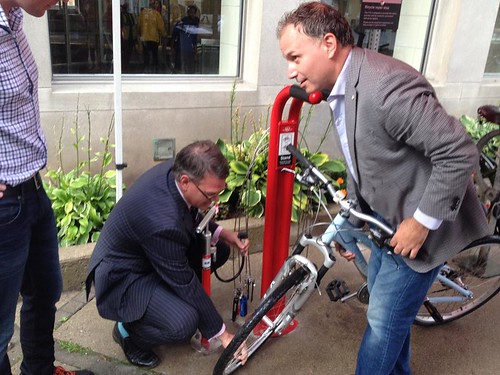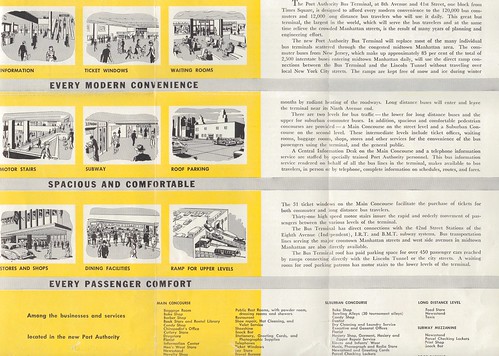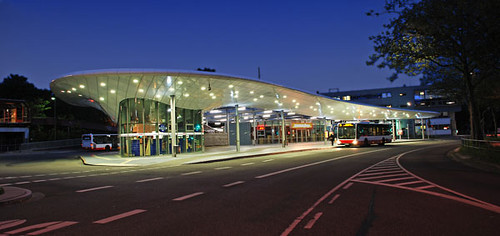Brief follow up on the Silver Spring Transit Center
It's already a very long piece ("Multiple missed opportunities in the creation of the Silver Spring Transit Center") but the comment thread etc. makes me realize I missed a couple things. And note that I did write about some of these issues 8 years ago ("[Bus] Transit Centers"). In that piece I wrote:
I don't think there's a good example in the DC region of a bus-oriented transit center that is both attractive and capable of accommodating a large amount of bus service. Most of the centers I am familiar with are attached to subway stations.This addendum is organized in order of increasing importance.
And judging by the renderings, the coming Silver Spring Transit Center looks to be a behemoth with no comparison to the grand (train) stations of old, despite the comparable size.
1. Biking. GGW mentions as did I, that a bike station is planned for a site adjacent to the SSTC.
While I think having a bike repair place etc. in the core of the business district is important, and there needs to be secure bike parking at the Metro station as a matter of course, these days I am less enamored with "bike stations" compared to what I thought 5-7 years ago, as discussed in "Ideas for making bicycling irresistible in Washington DC" from 2008 and the bike plan I did for Baltimore County in 2010. In my definition, bike stations have lockers and showers and usually offer repair services + secure bike parking.
It would be very interesting to do some research on the people who are using such stations in DC, Chicago, Long Beach, Indianapolis, and elsewhere, to get a better sense on the nature of the demand.
I think that cyclists prefer to park their bikes and shower at their final destination (work, school, etc.) rather than shower and park potentially a considerable distance away. That fact limits the utility of these stations, especially when they aren't located within central business districts as much as they are adjacent.
Note that a secure bike parking facility, such as those at the College Park and Wiehle Avenue Metrorail stations is not a bike station, but a form of secure parking.
In terms of defining bike facilities at a transit station in terms of what we might call levels of service, I see at least seven levels: bike parking and posted bikeways map signage; repair stands and air pumps; secure bike parking; bike equipment vending machine; on-site repair; showers and lockers; and bike sharing systems and rentals. The first three should be basic components for every major transit station.
 TTC Deputy CEO and Chief Customer Officer Chris Upfold and TTC Chair Josh Colle try out new bike repair stand, Davisville station, Photo: Stefan Novakovic, UrbanToronto.
TTC Deputy CEO and Chief Customer Officer Chris Upfold and TTC Chair Josh Colle try out new bike repair stand, Davisville station, Photo: Stefan Novakovic, UrbanToronto.The Toronto Star reports ("TTC offers bike repairs on the go") that in the past couple weeks, the TTC in Toronto started installing repair stands and air pumps at 10 stations, with plans to have such facilities at all the stations eventually.
2. Placemaking. I didn't discuss the "placemaking element" as it relates to the SSTC enough although I did reference the public realm framework concept and cited the post "The layering effect" which happens to discuss the topic at length, using as it happens, Silver Spring as the primary example.
I should have referenced the past entry, Transit, stations, and placemaking: stations as entrypoints into neighborhoods." but that was somewhat deliberate because that piece discusses transit stations as neighborhood gateways, therefore a smaller scale than the Silver Spring Transit Center, which is a station at a different position on the station hierarchy, serving a large district/conurbation.

Modern service elements common to major bus terminals. Flyer for the new Port Authority Bus Terminal, New York City. Circa 1950. You could think of these items as "placemaking elements" within a transit station.
3. Inter city bus terminals as a building type to reference for transit station design. The discussion in the comment thread on the SSTC post made me realize that because of the place that the Silver Spring Transit Center occupies in the hierarchy of transit stations in the area, region, and state, combining a Metrorail station with a higher quality bus station, even though that building type was developed to serve a different kind of user and trip, the inter-city bus terminal, usually serving longer distance trips, is another transit station type that should have been referenced in considering how to design the station inside and out.
The example stations that were mentioned, in Lancaster, PA and Rochester, NY, do reference that type, but I neglected to call that out.
Greyhound was known for its use of the streamline modern art deco architectural style for its stations, which was a dominant style during the period when the bus line was expanding rapidly across the nation.
Inter city bus terminals that would have been a good reference source in considering a design for the SSTC, in historic or modern styles include:
Greyhound Cleveland Bus Station (1948). Wikipedia photo.

Victoria Coach Station, London (1932). Brochure circa 1935. The station is still in use and run by Transport for London, the regional transit agency.

Preston, England Bus Station (1969). Flickr photo by Robert Wade. The station is a historic landmark and is slated to be converted into a youth center.

ZOB Hamburg Central Bus Port, Germany (2009). Photo from ZOB. Second photo from CITA. This station is located within a block or two of the main train station and has a subway station across the street.


Labels: bicycle and pedestrian planning, bus, bus stations, inter city bus service, railroad stations, station area planning, transportation planning



2 Comments:
4 things I missed:
1. Public art. More recently a mural was reinstalled in the walkway under the underpass on the south side of Colesville Road.
2. I missed the fact that the Transit Store should have been located on the ground plane, near/between the Metrorail Station and the Bus Station.
And that it isn't open weekends and it should be. (They could combine it with visitor center functions.)
3. The information signage showing the diagram of the bus station has three slots. One is a repeat of information on the other two slots.
It should have had area map signage.
4. Indianapolis Carson Transit Center wins awards. Amenities include wifi.
http://fox59.com/2017/10/23/indygo-transit-center-receives-awards-for-excellence-in-built-environment/
Thank you for providing such a valuable information and thanks for sharing this matter to get Online pharmacy from Dose Pharmacy medicine.
Post a Comment
<< Home